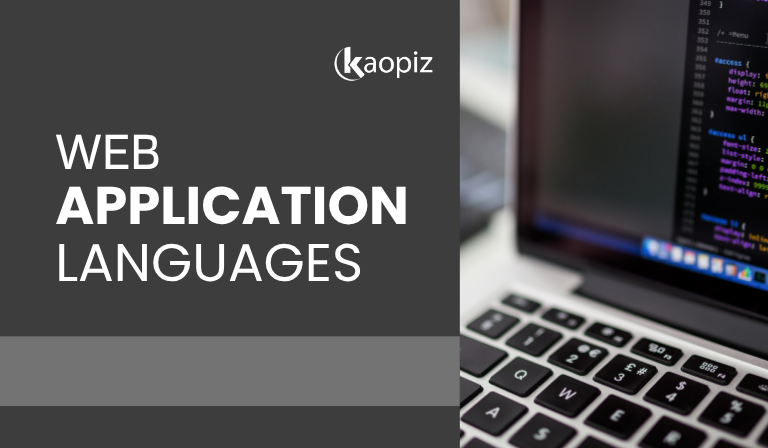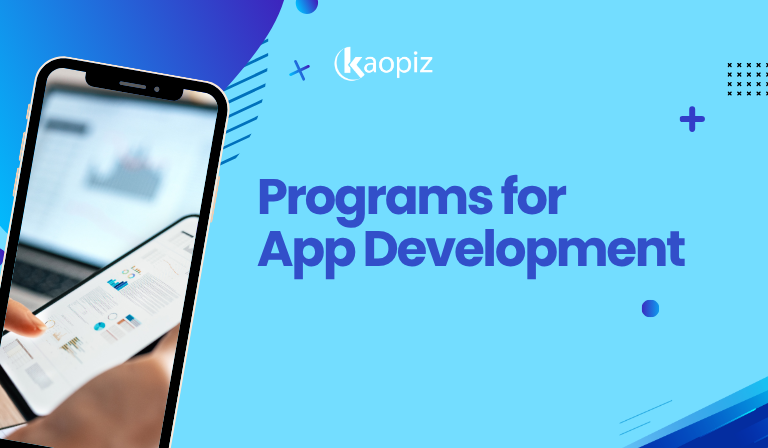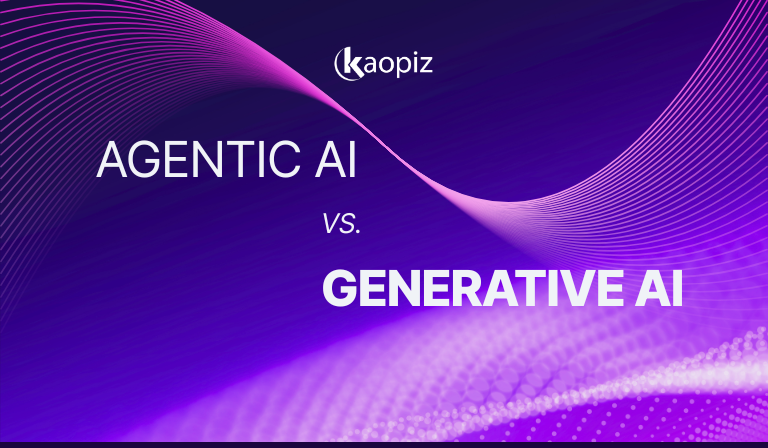What is Generative AI? How It Works & Its Applications
Generative AI is one of the most exciting and transformative advancements in our world. Unlike traditional AI, which typically focuses on analyzing data and making decisions, generative AI goes a step further by creating new, original content. From text and images to music and design, generative AI has the power to revolutionize industries, streamline processes, and unlock new creative possibilities.
In this blog, we’ll explore what generative AI is, how it works, its applications across different sectors, and the benefits and challenges it brings. Whether you’re a business looking to innovate or simply curious about this emerging technology, understanding generative AI is key to embracing its potential.
Table of Contents
- What is Generative AI?
- How Does Generative AI Work?
- Key Generative AI Models
- Benefits of Generative AI
- Challenges, Limitations, and Risks
- Applications of Generative AI
- The Future of Generative AI
- How Kaopiz Can Help with AI Development
- Conclusion
- FAQs
What is Generative AI?
Generative AI (Generative artificial intelligence or Gen AI) refers to a branch of artificial intelligence that focuses on creating new content, such as text, images, music, and even code, that closely resembles human-generated output.
The main goal is to create new, original content that mimics human-like creativity. Unlike traditional AI, which primarily analyzes data and makes predictions, Generative AI produces original and realistic outputs based on the patterns it learns from existing data.
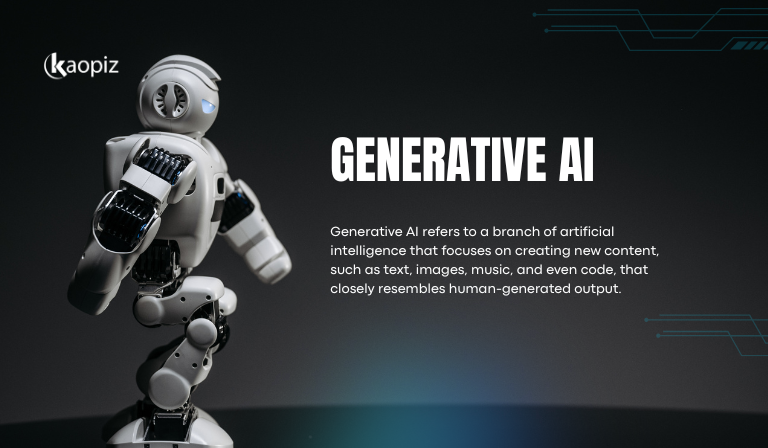
The key feature of generative AI is its ability to create new, original content by learning patterns and structures from existing data. Powered by deep learning models like Generative Adversarial Networks (GANs), Variational Autoencoders (VAEs), and Transformer-based models, it mimics the structure and style of input data to generate high-quality content.
How Does Generative AI Work?
Generative AI works in three main steps:
- Training: Creating a foundation model that serves as the base for various AI applications.
- Tuning: Customizing the model for specific tasks.
- Generation & Improvement: Producing content, evaluating results, and refining the model for better accuracy.
Step 1: Training the AI
Before AI can generate anything, it needs to learn from data. This step is called training. Developers give AI models large amounts of text, images, or videos from the Internet.
Then, what type of data is Generative AI most suitable for? It is most suitable for data that is structured, unstructured, or semi-structured, where patterns and relationships can be learned and leveraged to create new, similar content.
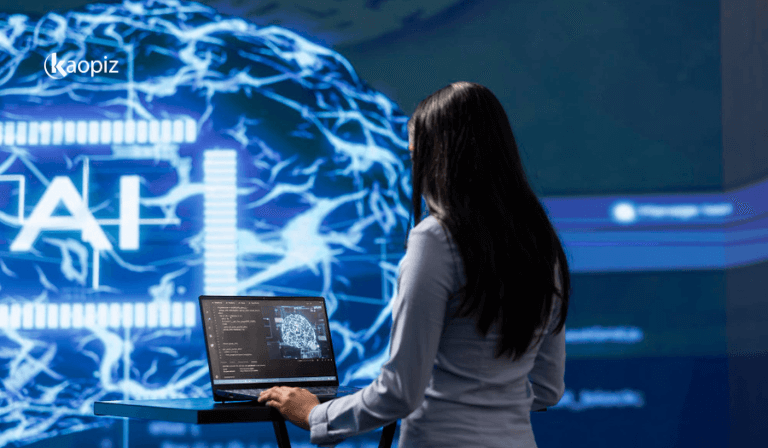
The AI then learns by playing a “fill-in-the-blank” game:
- If it’s a text model, it guesses the next word in a sentence.
- If it’s an image model, it predicts what pixels should come next.
Over time, the AI gets better at making predictions and can generate realistic content.
Fact: Training AI takes a lot of time, computing power, and money. Instead of training from scratch, companies often use pre-trained models like GPT-4 or Llama-2 to save costs.
Step 2: Tuning the AI for Specific Uses
A foundation model is like a general knowledge expert – it understands a wide range of topics but may not be specialized in a particular field. To improve accuracy for specific applications (e.g., a medical chatbot or a legal AI assistant), developers fine-tune the model using two key methods:
- Fine-Tuning (Adding Specialized Data): Developers provide the AI with labeled examples related to the specific task (e.g., customer service chats for a chatbot).
- Reinforcement Learning with Human Feedback (RLHF): Humans correct AI mistakes and rate its answers to help it improve.
Step 3: Generating, Evaluating, and Improving
After fine-tuning, the AI is ready to generate content based on user input. However, the process doesn’t stop there – continuous improvement is needed to enhance accuracy.
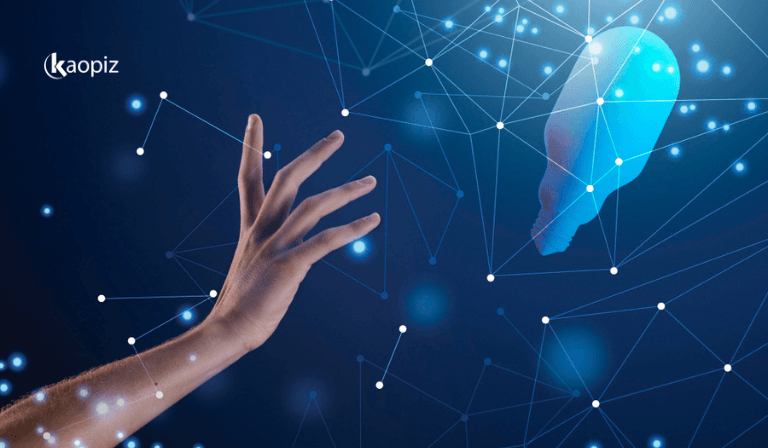
Developers and users regularly:
- Evaluate AI-generated content for quality and reliability.
- Make adjustments by further fine-tuning the model (sometimes weekly).
- Update knowledge sources using techniques like Retrieval-Augmented Generation (RAG).
It keeps getting smarter and more useful, helping with writing, image creation, coding, and more. However, it still needs monitoring to avoid mistakes or outdated information.
Key Generative AI Models
Gen AI is powered by different types of models, each designed for specific tasks like text generation, image creation, and even music composition.
Below are some of the most important types of generative AI models and their examples.
GANs
GANs consist of two neural networks – the generator and the discriminator – that compete against each other. The generator creates new images, while the discriminator evaluates whether they look real. Over time, the generator improves, producing highly realistic visuals.
Examples:
- This Person Does Not Exist: Generates AI-created human faces.
- DeepFake Technology: Used to create realistic fake videos.
- StyleGAN (NVIDIA)” Generates high-quality synthetic images.
Best for: Creating realistic images, videos, and even deepfake content.
VAEs
VAEs learn to compress and reconstruct data, allowing them to generate new variations of images, handwriting, and artwork. Unlike GANs, VAEs focus on keeping the output diverse rather than just hyper-realistic.
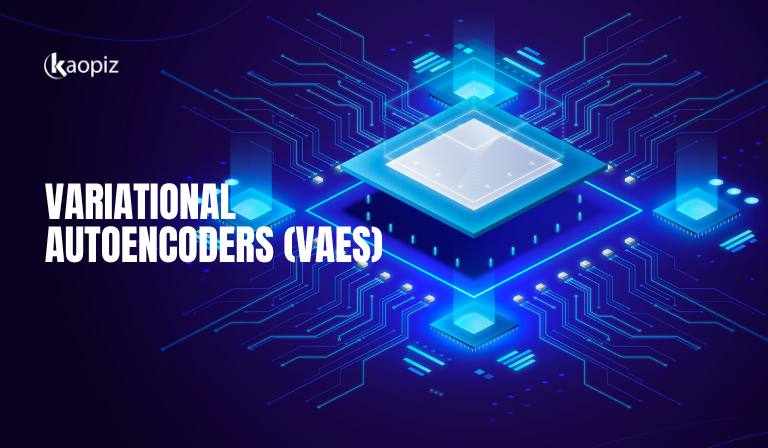
Examples:
- Handwriting Simulation: Used in AI-generated digital signatures.
- Data Compression: Reduces file sizes for efficient storage.
- Image Denoising: Enhances low-quality or noisy images.
- Medical Imaging: Improves MRI and CT scan clarity.
Best for: Creating realistic yet slightly altered images and designs.
Transformers
Transformers are a powerful AI model architecture widely used in natural language processing (NLP). They form the foundation of advanced language models like GPT-3 and GPT-4, which generate human-like text by predicting the next word based on previous context.
Examples:
- Content Generation: Writes articles, reports, and creative text.
- Language Translation: Converts text between languages with high accuracy.
- Chatbots & Virtual Assistants: Enables real-time, human-like conversations.
- Code Generation: Assists developers by generating and correcting code.
Best for: Processing and generating text with high accuracy, coherence, and contextual awareness.
Diffusion Models
Diffusion models generate high-quality images by gradually removing noise from random data. They first add noise to training data until it becomes unrecognizable, then train an AI to reverse this process, revealing a clear output.
Examples:
- Image Generation: Powers tools like DALL-E to create realistic and artistic images.
- Super-Resolution: Enhances low-resolution images with fine details.
- Style Transfer: Applies artistic effects to photos, making them look like paintings.
- Video Generation: Produces smooth, AI-generated video sequences.
Best for: Creating ultra-realistic, high-quality images and visual effects with fine control.
Benefits of Generative AI
Generative AI is revolutionizing industries by automating tasks, enhancing creativity, and improving efficiency. From content creation to personalized experiences, its applications continue to expand.
Enhanced Creativity and Innovation
It helps artists, writers, and designers create original content faster. Automating tedious tasks allows professionals to focus on refining and innovating their work.
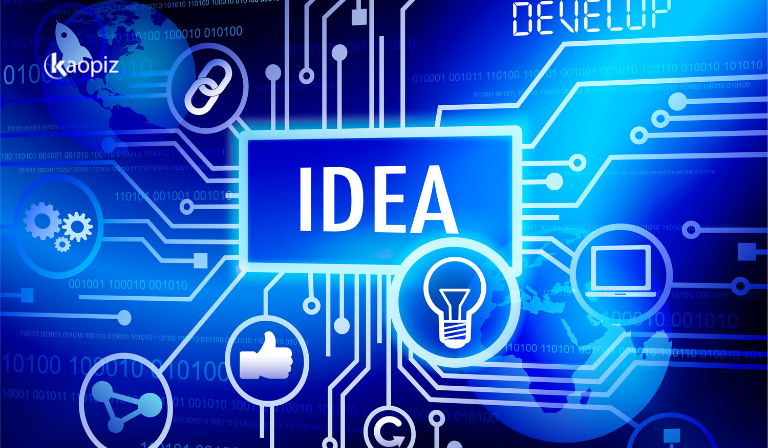
Example: A graphic designer uses AI-powered tools to generate multiple design concepts, speeding up the creative process.
Increased Productivity
It can generate text, images, code, and even music, significantly reducing manual effort. Businesses use AI to automate time-consuming tasks, allowing employees to focus on strategy and problem-solving.
Example: A software development team uses AI to generate code snippets, reducing development time.
Personalization and Customization
Generative AI tailors content based on user preferences, improving customer engagement and experience. AI-driven recommendations help businesses connect with their audience more effectively.
Example: A streaming platform like Netflix suggests movies based on users’ viewing history.
Better Decision-Making with AI-Generated Insights
Generative AI analyzes large datasets quickly, helping businesses and researchers make informed decisions. It can identify patterns, predict trends, and generate reports based on complex information.
Example: A financial analyst uses AI to detect market trends and predict stock fluctuations.
Reduced Costs
AI-powered tool speeds up processes, reducing the time and expenses required to complete tasks. By minimizing errors, eliminating inefficiencies, and streamlining workflows, businesses can significantly cut costs.
Example: A manufacturing company uses AI to simulate product designs before physical testing, reducing material waste and development costs.
Challenges, Limitations, and Risks
While gen AI offers numerous benefits, it also presents a range of challenges and potential risks that need to be addressed for effective and ethical use. These challenges include issues related to accuracy, bias, privacy, and ethical concerns.
Accuracy and Reliability
Generative AI models, despite their power, can sometimes produce incorrect or unreliable outputs. This is particularly problematic in critical fields like healthcare, legal, or finance, where accuracy is paramount. AI’s tendency to “hallucinate” (generate false or misleading information) can undermine its trustworthiness.

Bias in AI Models
AI systems are only as good as the data they are trained on. If training data contains biases, the AI model will likely replicate and amplify those biases. This can lead to unfair or discriminatory outcomes in applications such as hiring, loan approval, or content moderation.
Data Privacy Concerns
Generative AI models require vast amounts of data for training, often sourced from publicly available content. This raises concerns over data privacy, as sensitive personal or corporate information might be unintentionally included in the training data.
Ethical Dilemmas
Generative AI’s ability to create realistic fake content, such as deepfakes, raises significant ethical concerns. This technology can be used to spread misinformation, manipulate public opinion, or create harmful content.
Intellectual Property Issues
Generative AI can create original works, such as art, music, and literature, but the question of ownership and intellectual property rights is still unresolved. Who owns the content generated by AI? The user, the developer, or the AI itself? This legal gray area creates uncertainty around the use and distribution of AI-generated content.
Applications of Generative AI
Generative AI is transforming a wide range of industries by enabling the creation of new content, automating processes, and improving decision-making.
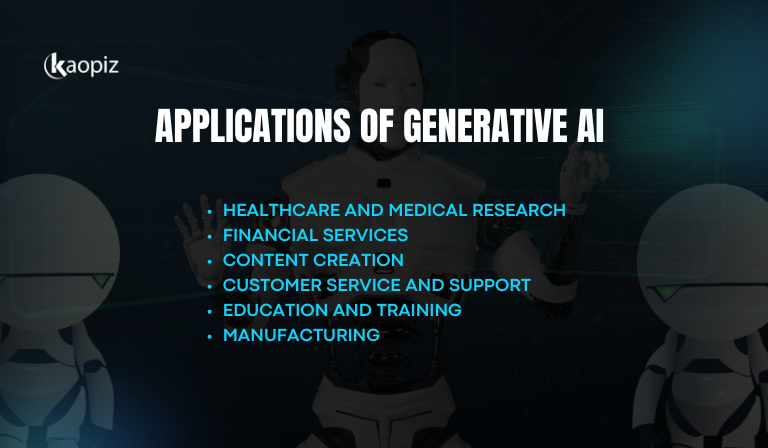
Below are some key areas where generative AI is making a significant impact:
- Healthcare and Medical Research: Used in medical imaging, drug discovery, and patient care. It generates realistic images from low-resolution scans, improves diagnostics, and helps design drugs by predicting molecular structures.
- Financial Services: Used in finance for tasks such as fraud detection, algorithmic trading, and risk management. AI can analyze vast amounts of financial data to identify trends and recommend investment strategies.
- Content Creation: Tools like GPT-3 are used for generating blog posts, articles, social media content, and even poetry. In the visual arts, AI can create images and designs, while in music, it can compose original songs.
- Customer Service and Support: Used to create chatbots and virtual assistants that provide customers with instant, human-like responses. These tools can answer common questions and resolve issues, improving the customer experience.
- Education and Training: Used to create personalized learning experiences and adaptive educational content. AI can generate quizzes and even provide feedback on student performance, helping educators tailor instruction to individual needs.
- Manufacturing: Enhance manufacturing by predicting maintenance needs to reduce downtime and extend equipment lifespan. It also improves quality control by inspecting products for defects, ensuring only high-quality items reach the market.
Generative AI continues to expand its applications across multiple industries, driving innovation, enhancing productivity, and creating new opportunities for businesses and individuals alike.
The Future of Generative AI
Gen AI is still in its initial stages, with significant potential to transform industries. While tools like ChatGPT are used for app development and have demonstrated their power, challenges such as cost and limitations in creative synthesis remain. Organizations are exploring how to harness AI to improve efficiency and reduce costs.
Despite these hurdles, innovation is driving progress. New frameworks like AutoGPT aim to improve accuracy, while platforms like Nvidia Omniverse push AI into the physical world. As generative AI tools become more integrated into existing workflows, they will streamline processes and enhance productivity across various sectors.
In the future, generative AI will continue to evolve, influencing areas like translation, drug discovery, and content creation. The most significant impact will come from integrating AI directly into the tools we use, changing how we work and raising new questions about the role of human expertise.
How Kaopiz Can Help with AI Development
Kaopiz is your trusted partner in AI development, offering tailored solutions to help businesses leverage the full potential of artificial intelligence. Whether you’re looking to enhance your processes, improve customer experiences, or accelerate innovation, we specialize in building AI solutions that align with your business objectives.
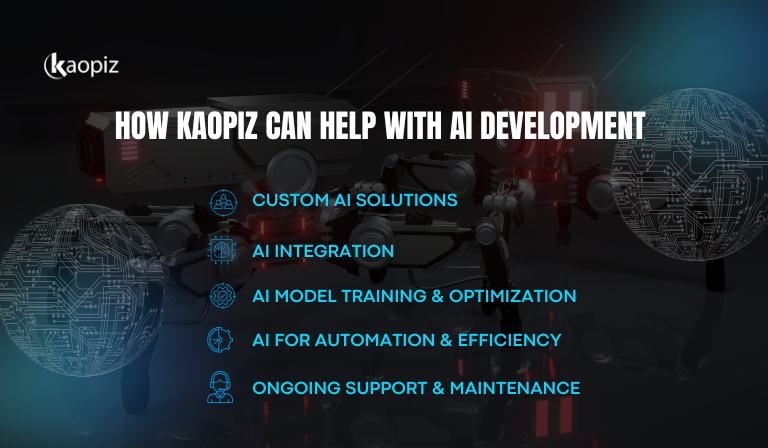
Here’s how we can support your AI development journey:
- Custom AI Solutions: We work closely with you to develop bespoke AI models that fit your specific business needs. From predictive analytics to natural language processing, our solutions help you solve complex challenges efficiently.
- AI Integration: Kaopiz ensures seamless integration of AI tools into your existing systems. Whether it’s integrating chatbots, machine learning models, or generative AI applications, we ensure that AI becomes a powerful tool in your workflow.
- AI Model Training & Optimization: Kaopiz specializes in training and fine-tuning AI models to enhance their accuracy and performance. We ensure your AI solutions are aligned with your business goals, delivering the best results.
- AI for Automation & Efficiency: We build AI solutions that automate repetitive tasks, freeing up time for your teams to focus on more strategic activities. Our solutions help reduce operational costs and increase productivity.
- Ongoing Support & Maintenance: After deployment, Kaopiz provides ongoing support to ensure your AI solutions continue to perform optimally. We monitor the models and adjust as necessary to keep your business ahead of the curve.
Partner with Kaopiz to transform your business with innovative AI technologies, designed to drive innovation, streamline operations, and create new opportunities for growth.
Conclusion
Generative AI is a groundbreaking technology with the potential to revolutionize various industries by enabling machines to create content, solve complex problems, and enhance human creativity. By understanding how generative AI works, from training and tuning models to generating diverse outputs, businesses can harness its power to improve efficiency, productivity, and innovation.
With applications spanning across industries like healthcare, manufacturing, entertainment, and marketing, generative AI is transforming how we work and interact with technology. While there are challenges and limitations, the ongoing advancements in AI research and the development of new frameworks promise to overcome these hurdles and unlock even greater potential.
Ready to leverage the power of Gen AI? Contact us today to explore how generative AI can transform your business and give you a competitive edge in your industry!
FAQs
What is the Difference Between Generative AI and Predictive AI?
Generative AI creates new content based on patterns learned from existing data, while predictive AI analyzes data to make predictions about future events or outcomes. Generative AI focuses on producing original content (e.g., images, text), whereas predictive AI is used to forecast trends or behaviors (e.g., sales forecasts, risk assessments).
Is Generative AI Replacing Jobs?
Generative AI is not necessarily replacing jobs, but is transforming the way work is done. It automates repetitive and time-consuming tasks, allowing humans to focus on more complex and creative work. While certain roles may evolve or be impacted, generative AI opens new opportunities for workers to collaborate with AI and leverages its capabilities to drive innovation and productivity.
What’s the Difference Between Large Language Models and Generative AI?
Large language models (LLMs), such as GPT-3, are a subset of generative AI. LLMs specifically focus on generating human-like text based on input prompts, using vast amounts of text data for training. Generative AI, on the other hand, encompasses a broader range of models, including those for image generation, music composition, and more. While all LLMs are part of generative AI, not all generative AI models are LLMs.
Trending Post
